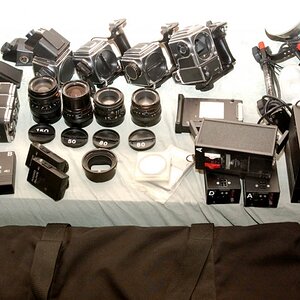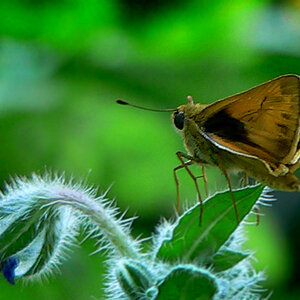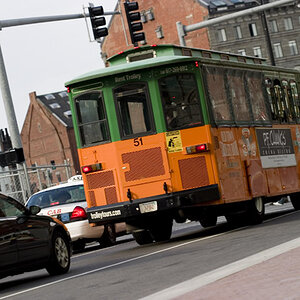Garfink
TPF Noob!
- Joined
- Jun 30, 2010
- Messages
- 7
- Reaction score
- 0
- Location
- Hong Kong
- Can others edit my Photos
- Photos NOT OK to edit
Hiya everyone, I've learnt tons from reading the forum of late and I figure I will contribute something back. So I have started a blog about photography. Its called: HK Camera Life, here is an example article that I have written. Please pay me a visit and tell me what you think! Any feedback would be greatly appreciated.
Myth busting: Lens Contrast
There is often debate on many forums about the topic of lens contrast. In this modern age of lenses, the fidelity of lens contrast is getting higher and higher. The reason for this increase contrast is better control of flare. This flare is caused by stray light that doesnt come from the reflected light from the objects in the scene and hence doesnt contribute to the photographic details of the photo. This light from high angle of incidence enter the lens through the front element and bounce around inside the lens barrel and cause reflections on the internal elements and some will reach the sensor or film and exposure the film/sensor in a random but uniform way. This stray light causes the photograph to become lighter in color and tone overall, especially obvious in the dark areas of the photo. Obviously there is a cost to this flare, it veils the midtones and light tones and the dark tones, as a result there is some lost in details or dynamic range all areas. This loss in detail is less apparent in the light areas.
There are two improvements in the modern lens that impact this the most, one is the modern multi-coating on the front elements that disperses the light coming from high angles and the improve absorptive properties of the inner lining of the lens barrel. This results in a high contrast and a greater dynamic range. There is talk that goes around that says that the blacks are blacker, but even though this is true in an empirical sense, a better description and a more accurate description is that the blacks appear blacker because there is less flare. If you consider it in terms of the tonal curve, for any given picture, a high contrast lens with low flare will have a wider dynamic range, which is overall a good thing. In other words: A high contrast lens will provide more tonal information than a low contrast lens.
So why are there so many advocates for low contrast, antique lenses? Why do photos look better sometimes with a low contrast lens?
The answer lies in the limited dynamic range of our sensors and the even more limited range of film. If the curve is wider you will exceed the ability for the sensor/film to capture the dynamic range of the scene. I like to think of it this way: I sometimes use HDR techniques in processing of some photos to improve the dynamic range, the HDR photo that results have too many colors & tones for the monitor to display and you have to remap the colors to shrink the dynamic range to usable levels (within the range of the color space youre using). There exists very expensive HDR monitors that can exhibit this HDR photos in their original glory, but since these monitors are not in general circulation at the moment we have to limit the dynamic range. The same thing occurs with a low contrast lenses: you essentially are compressing the dynamic range at the level of the lens by truncating the blacks in the photos, this is obviously advantageous with film where the dynamic range of the film is very low and the end result less malleable unlike a RAW file. Traveling with this train of reason, low contrast lenses will benefit positive slide film when compared to negatives, because the dynamic range of negatives are better.
The advantage of low contrast for modern digital sensors is dependent on the scene being photographed. A low contrast scene like my photo of the bas-relief at Angkor Wat is low contrast to begin with, almost the whole scene is uniformly lit & in the shade and the use of low contrast lenses will make this scene look very flat. The bas-relief will look less 3D with less pop and this will result in less impact.
For a very sunny high contrast scenes with details hidden in the shadows and much of the scene are highlights, the scene is beyond the dynamic range of the sensor and as a result of using a low contrast lens, we compress the dynamic range at the level of the lens and when balanced with the degradation of information due to flare, we may still benefit from using a low contrast lens. So my street scene of Lhasa taken with the more nostalgic Summicron would benefit even more from a lower contrast lens.
I think that even for a medium contrast scenes, digital sensors are better off with high contrast lenses.
In the future as the dynamic range of our digital cameras improves, the need for low contrast lenses will decrease. Even in the present, with judicious use of HDR techniques this is already true. Will this make low contrast lenses obsolete one day? Yes and No. Yes for digital and forever no for film users.
Myth busting: Lens Contrast
There is often debate on many forums about the topic of lens contrast. In this modern age of lenses, the fidelity of lens contrast is getting higher and higher. The reason for this increase contrast is better control of flare. This flare is caused by stray light that doesnt come from the reflected light from the objects in the scene and hence doesnt contribute to the photographic details of the photo. This light from high angle of incidence enter the lens through the front element and bounce around inside the lens barrel and cause reflections on the internal elements and some will reach the sensor or film and exposure the film/sensor in a random but uniform way. This stray light causes the photograph to become lighter in color and tone overall, especially obvious in the dark areas of the photo. Obviously there is a cost to this flare, it veils the midtones and light tones and the dark tones, as a result there is some lost in details or dynamic range all areas. This loss in detail is less apparent in the light areas.
There are two improvements in the modern lens that impact this the most, one is the modern multi-coating on the front elements that disperses the light coming from high angles and the improve absorptive properties of the inner lining of the lens barrel. This results in a high contrast and a greater dynamic range. There is talk that goes around that says that the blacks are blacker, but even though this is true in an empirical sense, a better description and a more accurate description is that the blacks appear blacker because there is less flare. If you consider it in terms of the tonal curve, for any given picture, a high contrast lens with low flare will have a wider dynamic range, which is overall a good thing. In other words: A high contrast lens will provide more tonal information than a low contrast lens.
So why are there so many advocates for low contrast, antique lenses? Why do photos look better sometimes with a low contrast lens?
The answer lies in the limited dynamic range of our sensors and the even more limited range of film. If the curve is wider you will exceed the ability for the sensor/film to capture the dynamic range of the scene. I like to think of it this way: I sometimes use HDR techniques in processing of some photos to improve the dynamic range, the HDR photo that results have too many colors & tones for the monitor to display and you have to remap the colors to shrink the dynamic range to usable levels (within the range of the color space youre using). There exists very expensive HDR monitors that can exhibit this HDR photos in their original glory, but since these monitors are not in general circulation at the moment we have to limit the dynamic range. The same thing occurs with a low contrast lenses: you essentially are compressing the dynamic range at the level of the lens by truncating the blacks in the photos, this is obviously advantageous with film where the dynamic range of the film is very low and the end result less malleable unlike a RAW file. Traveling with this train of reason, low contrast lenses will benefit positive slide film when compared to negatives, because the dynamic range of negatives are better.
The advantage of low contrast for modern digital sensors is dependent on the scene being photographed. A low contrast scene like my photo of the bas-relief at Angkor Wat is low contrast to begin with, almost the whole scene is uniformly lit & in the shade and the use of low contrast lenses will make this scene look very flat. The bas-relief will look less 3D with less pop and this will result in less impact.
For a very sunny high contrast scenes with details hidden in the shadows and much of the scene are highlights, the scene is beyond the dynamic range of the sensor and as a result of using a low contrast lens, we compress the dynamic range at the level of the lens and when balanced with the degradation of information due to flare, we may still benefit from using a low contrast lens. So my street scene of Lhasa taken with the more nostalgic Summicron would benefit even more from a lower contrast lens.
I think that even for a medium contrast scenes, digital sensors are better off with high contrast lenses.
In the future as the dynamic range of our digital cameras improves, the need for low contrast lenses will decrease. Even in the present, with judicious use of HDR techniques this is already true. Will this make low contrast lenses obsolete one day? Yes and No. Yes for digital and forever no for film users.


![[No title]](/data/xfmg/thumbnail/37/37522-f67b10bc5ee534f9bc21ee94917445b9.jpg?1619738129)
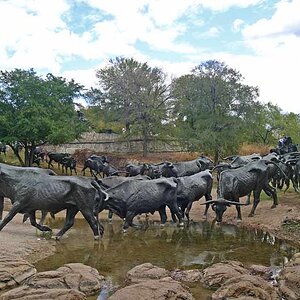
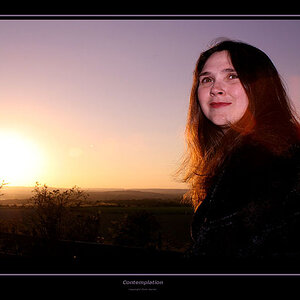


![[No title]](/data/xfmg/thumbnail/41/41923-ddfdc5596c5073ae69761e32124481cf.jpg?1619739945)


